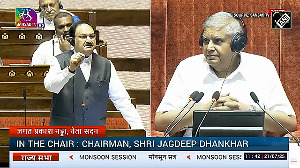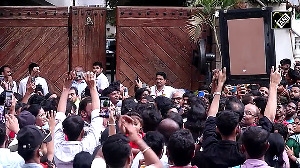On the morning of September 21, the floundering Commonwealth Games preparations received another severe setback. A 95-metre long pedestrian footbridge outside the Jawaharlal Nehru stadium collapsed, injuring 23 workmen.
The setback occurred 12 days before the scheduled opening of the Games. The bridge, a critical link between the stadium car park and its arena, was indispensable for the security, convenience and safety of participants, spectators and staff.
The beleaguered CWG Organising Committee, after wasting four precious days in muddle headedness, finally asked the Indian Army for a bailout on September 25. The army accepted the formidable challenge and constructed a replacement bridge by September 30.
The chances of the army reneging on its commitment are about as remote as the chances of 60-ton Arjun tanks trundling over this bridge into the Jawaharlal Nehru stadium, as one slightly ballistic television reporter probably implied, while breathlessly breaking news about this development.
What he undoubtedly meant was that the bridge would have that kind of ruggedness. He is right.
At a time when we are hosting a world event, using ad hocism and verbal calisthenics more than a well thought out plan of work, it is worth examining the methodology which the army used to deliver the bridge as scheduled.
Notwithstanding the fact that the organising committee chief Suresh Kalmadi, was airily dismissive of a Plan B (a plan to take care of unforeseen contingencies), the army, without even being placed on warning, must have mobilised its engineers (colloquially called Sappers) for a replacement bridge within hours of the collapse of the bridge, in the belief that, finally, the buck could stop at its doorstep.
A task force must have been earmarked, its leader and second-in-command nominated, and a physical staff check carried out on the total equipment and tools needed for bridge construction plus a spare 50 metres.
The design section must, at the same time, have carried out an anticipatory reconnaissance on the site.
It is not beyond the meticulous and time tested army planning norms that the bridge material must have been concentrated in one location, loaded in designated vehicles, (each with its own load table) and kept ready for move with a route and distance map given to each vehicle commander.
Grouped with the equipment would have been the supporting engineer vehicles like cranes, earthmovers, fork lifts, survey vehicles, radio communications, a water tanker, a mobile kitchen, fresh and dry rations, a langar with cooks, cooking wherewithal, cleaning staff and, not the least, an ambulance for self-contained 24x7 site servicing of the task force.
On site, the work would proceed with military precision with specific soldiers detailed for each sub task; from dismantling the existing structure to identifying on the ground how exactly the new bridge would come up.
The actual construction would then proceed with the minimum of fuss, as per the method plotted on a PERT chart.
(A PERT chart is a very useful project management tool used to schedule, organise, and coordinate tasks within a project. PERT stands for Program Evaluation Review Technique.)
It helps identify the critical path to be followed for task execution and indicates possible bottlenecks and how they should be negotiated.
It goes without saying that, in the final analysis, it is inspired, hands-on leadership and a practical feel for the task that gets high grade work done, and on time.
Part of the working style of the Army Sappers would have been the critical need for a 24x7 insight into actual work done, in percentage or man-hour terms plotted against the available time.
This is deliberately reduced by the Sapper commander by five to ten per cent in order to spur the men to greater effort.
This also ensures that work is finished within the overall time allotted.
The situational awareness at all levels of command and work execution is therefore planned in such a manner that everyone in the chain knows in real time how much work has been completed and how much is left to be done and thus be in a position to help with resources or with decisions in real time rather than when it is too late.
Not the least, is the fact that each nut, bolt, strut, weight bearing member is clearly marked, taken to its fitment location, fitted, tested, certified, re-tested and only then does construction continue.
Human error or over-confidence is thus ruthlessly eliminated within the task force, as also by on site Sapper officers who monitor construction with hawk-like alacrity, but interfere only when a safety norm is violated, so that overall bridge safety is not compromised.
A Bridge Too Far is a 1977 epic war film based on the 1974 book of the same name by Cornelius Ryan. The film tells the story of the failure of Operation Market Garden during World War II, the Allied attempt to break through German lines and seize several bridges in the occupied Netherlands.
British Lieutenant General Frederick Browning, deputy commander of the First Allied Airborne Army, who actually led the attack, reputedly told Field Marshal Bernard Montgomery, the operation's architect, before the operation, 'I think we may be going a bridge too far.'
It is a point for consideration for those in authority that, maybe, the huge national embarrassment caused by the CWG organisers would have been avoided had they planned their work with the same vision, methodology, eye for detail and uncompromising integrity as the army is doing, in delivering the bridge on time.
They would then not have gone 'a bridge too far' to use the war film analogy; of substituting rhetoric and an affected, 'all is or will be well' bonhomie for well planned and brilliantly executed, timely work as should have been the true work ethic of the Delhi CWG organisers.
ALSO SEE:
Army rebuilds fallen CWG bridge in four days
Video: Army builds bridge in record time
Complete coverage: The Commonwealth Games









